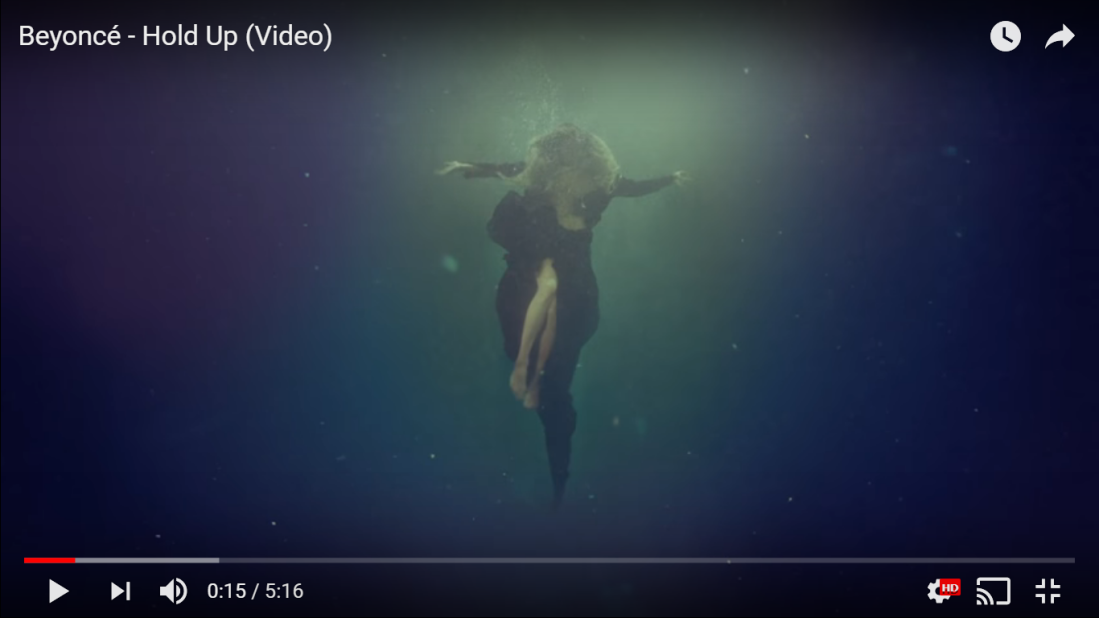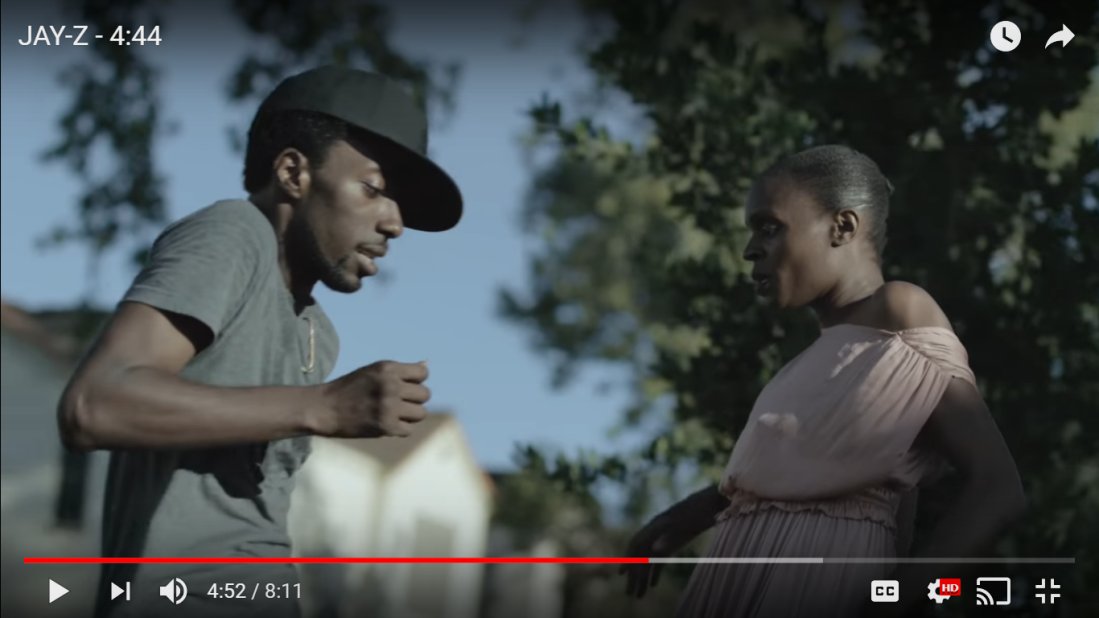Partners: Jesus Boone & Kalib Eddings
The relationship between mainstream music icons Beyonce & Shawn ‘Jay-Z’ Carter has been making headlines for over a decade now. While many celebrity partners have their share of relationship drama in the media, no couple of today has really been able to express it to the pubic in the controlled way Beyonce & Jay-Z did. Often thought to be perfect and free of fault, it wasn’t until Beyonce released her artistic visual album Lemonade (2016) did we think something was wrong with the musical power couple (well, Solange did try to warn us in that elevator footage). Lemonade told the story of a woman of color in the US South experiencing personal growth through heartache, betrayal, and self-care in a tumultuous political climate. Feminists all over debated whether artistic Queen Bey used her character as a vehicle to tell her own story or the story women of color experience across the United States. Once we went through the album’s drop and subsequent pregnancy journey, Jay-Z then released his latest album 4:44 (2017). In it we learned the truth of Jay-Z’s long term infidelities as he raps about his remorse and personal dedication to growth. By comparing this powerful POC couple to other mainstream artists, it can be said that they represent alternative feminine and masculine identities (reminiscent of the idea of Resistant Masculinities by Frederick Dhaenes and Sander De Ridder & Inclusive Masculinities by Patrick Eubanks) of what it means to be a celebrity musician in the genres of Pop and Rap/R&B. While staying within their respective genres as mainstream artists, Beyonce & Jay-Z both were able to maintain personal conflict to themselves and celebrate their love and triumph with their art. By focusing on the music videos for Hold Up, All Night, and 4:44 as well as examining some of their lyrics, we will work to clearly showcase how Bey & Jay-Z come to represent alternative identities through their music.

The second part of Lemonade the visual album is marked as ‘Denial’. At the start of the music video for Hold Up, Beyonce descends into the murky depths of her anxiety as she monologues her inner thoughts. Struggling with recognition of her relationship’s problems she purges herself to try and make sense of why she was wronged (Fasting for / 60 days / Wore white / Abstained from mirrors / Abstained from sex / Slowly did not speak another word / In that time my hair / grew past my ankles / I slept on a mat on the floor / I swallowed a sword / I levitated). The visuals are dark and heavy, which is why come cue for the song it is so striking to see Bey open an ornate cathedral door as the water cascades around her in a regal golden flowy gown. The attitude immediately changes to upbeat as the beat starts and Beyonce sings and raps over how bad her partner messed up ( What a wicked way to treat the girl that loves you ). Contrary to modern gender roles assigned to [cis] women, Beyonce is not complacent in her emotions at all. She is shown carrying a baseball bat aptly named ‘Hot Sauce’ (in reference to another song on the album, Formation) and vents her confusion and rage onto nearby car windows and fire hydrants. Rather than appearing furious the whole time, Bey dances in the faux rain from busted hydrants, laughs and twirls around with her bat, giggling at the destruction her man brought about.


The varying themes of the African religion of Yoruba in this music video specifically reflect a deity known as Oshun. Notable as the spirit of beauty, love, prosperity and order, she is often associated with the color yellow and hand mirrors (I hop up out my bed and get my swag on / I look in the mirror say ‘What’s up?’) which she offers to others in order to self reflect (Jaide). While Oshun is known to be compassionate and all-loving, when her trust is broken she is told to release an unbridled fury that is deserved. Beyonce invoking this decolonized feminine identity in order to further validate her own struggles completely goes against what mainstream feminine identities often represent; a subdued woman who struggles to be heard. Beyonce refuses to be silenced and intends to construct mayhem in order for her point to be heard.

Jumping towards the end of the visual album, the second to last song All Night, Beyonce concludes her story with ‘Redemption’. She is shown at a manor with other woman of color. They are shown cultivating a garden and home for themselves together as peace and joy is about. For Beyonce, she has finally made peace with what she has been put through. This representation of a calm and collected feminine identity stays true to what normative gender roles allow for women, but Beyonce exhibits these traits in a greater sense than just complacency. She went through the process. She dealt with it and fought back for what she deserves. The man who broke her heart knows it and is trying to make up for his mistakes. Beyonce was the one wronged and is now in control of the relationship dynamic — even though she loves him, that doesn’t mean she will run back to him. Beyonce needs examples of growth and recognition of what needs to change in order to get her relationship back to where she and her partner want it to be;
“Found the truth beneath your lies
And true love never has to hide
True love never has to hide
I’ll trade your broken wings for mine
I’ve seen your scars and kissed your crime
So many people that I know, they’re just tryna touch ya
Kiss up and rub up and feel up
Kiss up and rub up and feel up on you
Give you some time to prove that I can trust you again
I’m gonna kiss up and rub up and feel up
Kiss up and rub up and feel up on you
…
They say true love’s the greatest weapon
To win the war caused by pain, pain
But every diamond has imperfections
But my love’s too pure to watch it chip away
Oh nothing real can be threatened
True love breathes salvation back into me
With every tear came redemption
And my torturer became my remedy”

As Beyonce ends her emotional showcase, the spirit of strength of her song represents her actions. She wants to be with Jay-Z, as much as she wants happiness for her family. She chooses what she desires and works problems out. As the ending of the song plays, videos and pictures of her family flash by to show her audience what she finds most important, encouraging the audience to do the same and cherish what matters to them. This positive portrayal of tension and conflict in relationships shows a different perspective for others to learn from as well as appreciate.

It’s interesting to observe the album 4:44 after actively engaging in the discourses surrounding Lemonade. Similar to Beyonce, Jay-Z uses his music videos to abstractly touch on his personal life and address concerns around the celebrated relationship he has. As the montage of shots in the music video stream by, the first major visual connection to his wife’s work comes in the form of a still from her Hold Up music video. Jay-Z is adeptly owning up to his own mistakes with lyrics such as;
Look, I apologize, often womanize
Took for my child to be born, see through a woman’s eyes
Took for these natural twins to believe in miracles
Took me too long for this song, I don’t deserve you

As easy at it would be to deflect his wrongs, Jay-Z insists he is at fault. He has struggled to mature and is opening up about it as he needs to keep his love. The artistic visuals continue as dancers portray him and his wife and the struggles they both face. Jay-Z continues to lament on his mistakes he is owning up to and worrying on;
You matured faster than me, I wasn’t ready
So I apologize
I seen the innocence leave your eyes
I still mourn this death and
I apologize for all the stillborns cause I wasn’t present
Your body wouldn’t accept it
I apologize to all the women whom I toyed with your emotions
‘Cause I was emotionless
And I apologize ’cause at your best you are love
And because I fall short of what I say I’m all about
Your eyes leave with the soul that your body once housed
And you stare blankly into space
Thinkin’ of all the time, you wasted it on all this basic shit
So I apologize

Though the tone is more cynical, as the title song of the album, 4:44 represents an embark from the usual hardcore exterior Jay-Z exhibits. This alternative masculinity is one that accepts mistakes and reflects on them. One that, instead of focusing on superficial topics involving relationships, digs into the complexities in order to aptly address and fix them. Societal gender norms for masculine identities often provide cues to be emotionless, something Jay-Z called himself in this song. Yet by delivering this sad and somewhat self-hating song, Jay-Z opens the doors to the public to understand his mind and emotions on a deeper level than most often. Maybe it’s his new family lifestyle sobering him up towards the reality of being in a committed relationship or maybe it was the pain he so clearly caused his loved ones. Either way, Jay-Z pulled a move most cis-heterosexual men would hesitate to make and he did it via an album.
Although the true personal life of Beyonce & Jay-Z are privy to only themselves, recognizing these attempts at breaking the mold for masculine and feminine identities in a relationship is important. As social icons, Bey and Jay-Z both used their platforms to address rumors while also keeping the matter really quite personal. By leading as an example, Beyonce shows that women have agency and can uphold standards when in relationships in order to protect themselves from emotional abuse and harm. Jay-Z compliments this by admitting his own mistakes, publicly allowing men to see that an emotionless and stoic facade is not necessary and can only cause more harm than ever intended to. The fact that, as people of color, Beyonce & Jay-Z took this moment as a time to educate and represent their culture and backgrounds truly highlights the character both of them hold. Conflicts will arise and as Bey & Jay-Z showed us, it can be resolved with effort and communication.
Cite:
Dhaenens, Frederik, and Sander De Ridder. “Resistant Masculinities in Alternative R&B? Understanding Frank Ocean and The Weekndâs Representations of Gender.” European Journal of Cultural Studies, vol. 18, no. 3, 2014, pp. 283–299., doi:10.1177/1367549414526730.
Hobson, Janell. “Beyonce’s Fierce Feminism.” Ms. Magazine, 7 Mar. 2015, msmagazine.com/blog/2015/03/07/beyonces-fierce-feminism/.
